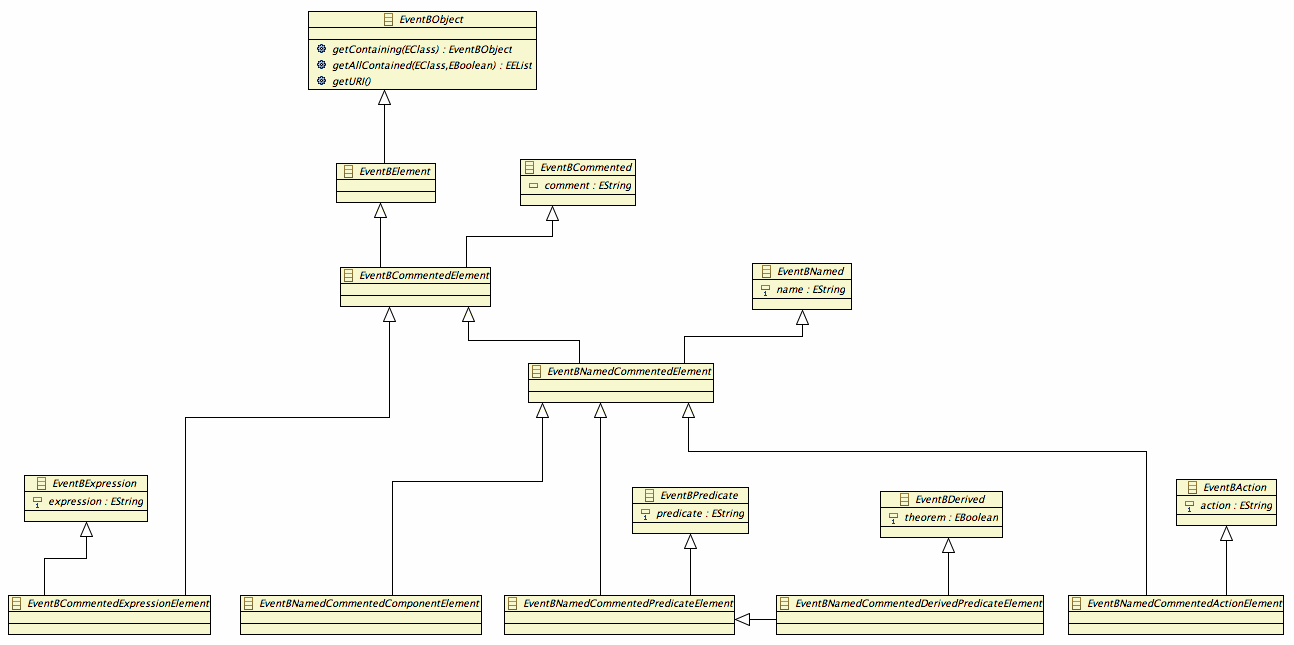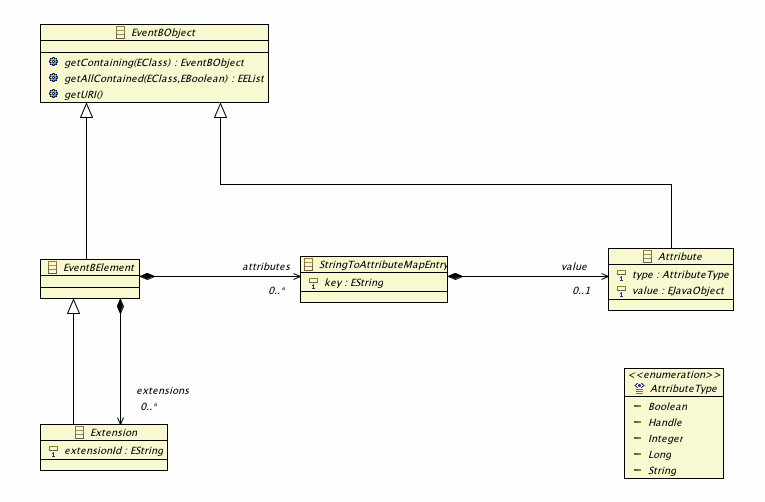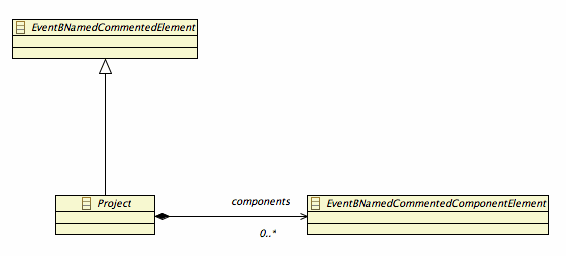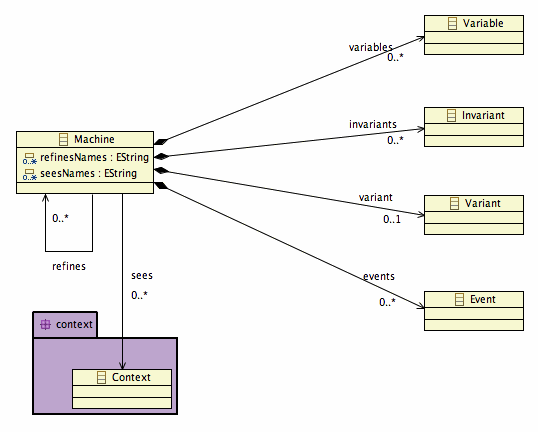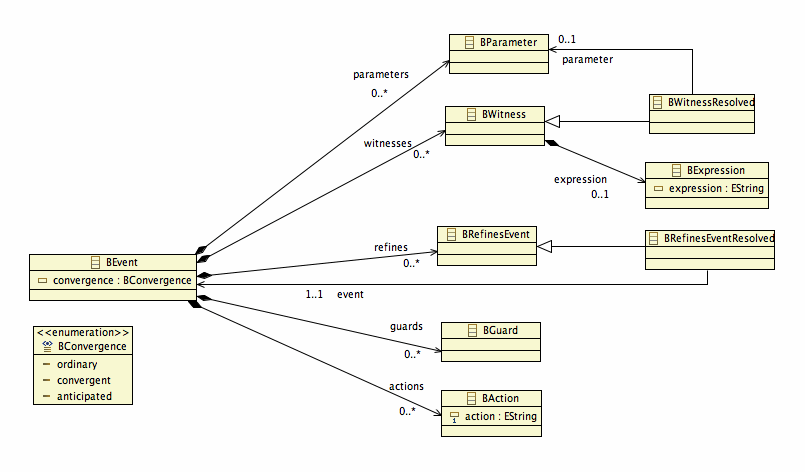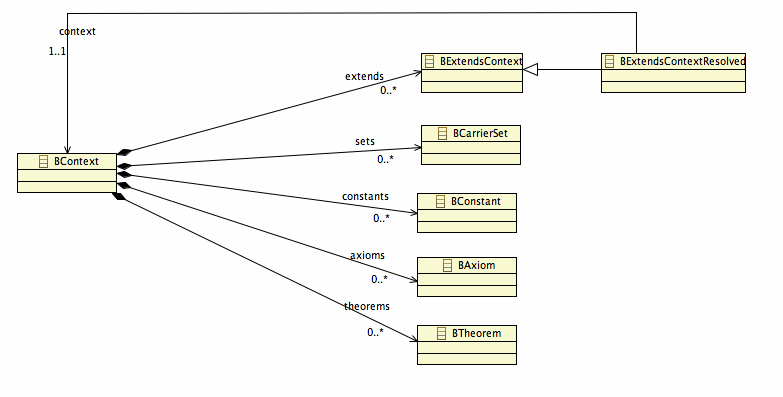EMF framework for Event-B
This page is edited by Colin, Alexei and Fabian
An EMF Model of Event-B
| Warning:
This page is being updated and is currently inconsistent and inaccurate in some areas |
The Eclipse Modeling Framework
The EMF project is a modeling framework and code generation facility for building tools and other applications based on a structured data model. From a model specification described in XMI, EMF provides tools and runtime support to produce a set of Java classes for the model, along with a set of adapter classes that enable viewing and command-based editing of the model, and a basic editor.
Event-B Meta-Model
The Event-B meta-model defines the structure of Event-B projects. The model is structured into three packages for clarity. The core package contains a structure of abstract meta-classes so that models can be treated in generically as far as possible. The core package also contains mechanisms to handle extensions provided by other plug-ins and a meta-class to model entire projects. There are two sub-packages, contained with the core package, for Machine and Context.
The root of all elements is the abstract base class, EventBObject this provides some convenience methods to access containing or contained elements of a specified type and a method to obtain the URL of an element's package. EventBObject extends the EMF class, EModelElement, which provides a facility to store EAnnotations in any EventBObject. (EAnnotations give a flexible and efficient way to store information that is not part of the main model. For example this is used to store some information contained in the Rodin database, which must be preserved but is not of interest in the EMF modelling tools).
EventBElement provides a common base class for all EventBObjects that are elements of the model. ???this meta-class has a string attribute, comment. (Hence all elements can be commented).
Some elements are named. These elements are based on the abstract base class, BNamedElement, which has a string attribute, name.
Some elements are predicate elements. These elements are based on the abstract base class, BNamedPredicate, which has a string attribute, predicate.
Some elements are expression elements. These elements are based on the abstract base class, BExpression, which has a string attribute, expression.
References between elements are handled by a specialisation of BReferenceElement which contains the name of the element to be referenced. This can be replaced by a subtype, which contains the link to the referenced element. This allows text editors to reference other elements by name which is later resolved (if possible) to a proper link.
The Extension Mechanism
The abstract root meta-class, BElement, contains a collection, extensions, of another abstract meta-class, BExtension. BExtension can be specialised in other EMF models to define extensions of the model. Extension classes should override the abstract load and save methods of BExtension in order to define their specific requirements for serialisation.
Project
A Project contains a collection of components. Project extends EventBNamedCommentedElement. This allows it to contain Extensions and Attributes as well as providing it with a name and comment.
Machine package
A Machine inherits from component (so that it can be used in the components collection of a Project). Machines, refine other machines (via a subtype of BReferenceElement which may be resolved), see contexts (via a subtype of BReferenceElement which may be resolved), and may contain, variables, invariants, theorems, a single variant and events.
Event package
Events contain parameters, witnesses, refines relationships with other events, guards and actions. Witnesses, link with other parameters (via a subtype of BReferenceElement which may be resolved). Similarly, event refinement relationships link to other events (via a subtype of BReferenceElement which may be resolved). The enumerated type, BConvergence, provides the values for the convergence property of an event.
Context package
A Context inherits from component. Contexts, extend other contexts (via a subtype of BReferenceElement which may be resolved), and contain sets, constants, axioms and theorems. (Note that the BTheorem meta-class is the same one that appeared in the Machine package).
Event-B Mathematical Language Extension
Using the Extension mechanism an EMF extension for the Mathmetical Language of EventB will be created. This means expressions, predicates and substitutions will be available as EMF models too.
As the RodinDB only saves these constructs as plain strings, their EMF representation will be recreated every time a model is loaded. The existing RodinParser in combination with a conversion component will be used for this task. To avoid unnecessary parsing the creation of these models will be postponed until the models are needed. For example, it will be up to the tool developers to decide when they need a fully resolved structure of predicates. API methods in the Text Tools will ease parsing and model construction for tool developers.
Persistence
The Persistence package will override the default EMF persistence so that models created with the Event-B EMF framework will be serialised into the Rodin Database. The serialisation will make use of the Rodin API so that it is decoupled from the serialisation of the Rodin database. Serialisation will synchronise changes with the Rodin Database so that only elements that have been altered are updated. The Persistence API will provide methods to open/create Rodin projects, load and unload components (from Rodin Database to cache), save changes, register listeners to projects and components and resolve references between elements.
Text Tools
As several tools based on the EventB meta-model will deal with a textual representation of it, a component called 'Text Tools' will be created. Text Tools will offer an API for basic tasks such as:
- Define a concrete syntax for the structure of machines and contexts
- Conversion from an EventB meta-model to text, i.e., pretty-print with configurable layout
- Parsing of text input which produces an EventB meta-model
Structural parsing
The Rodin core already provides a parser for expressions, predicates and substitutions. Therefore Text Tools will only provide a parser for the structural parts of the text representation of EventB machines and contexts. This parser will treat expressions, predicates and substitutions as plain strings that are stored in attributes in the meta-model. As described in section Event-B Mathematical Language Extension the full mathematical language will be supported as an extension to the EventB meta-model. Tools that are interested in working on a fully parsed version of an expression, predicate or substitution will be able to use helper methods of the Text Tools API. These helper methods will make use of the existing Rodin parser and convert the resulting AST to the meta-model.
Fallback strategy
When the user is editing the textual representation of a machine or context the input may contain syntactic errors which prevent converting the parse result into an EMF model. As the user might wish to save the text representation in this syntactically incorrect state, Text Tools will provide a fallback strategy for this case. API methods will be provided to store the plain text into the RodinDB. This plain text will be used as a basis for editing next time the model is loaded via Text Tools.
Conflict resolution
When Text Tools loads an EventB meta-model from the Rodin Database it will detect any conflicts in the model. Conflicts will occur if other editors, that do not work via Text Tools, have changed the model in the RodinDB after Text Tools has stored a syntactically incorrect version as plain text. In this case the tool that is using Text Tools to load the model will be informed about the conflict and asked to resolve it. Strategies to solve these conflicts could be 'automatic overwriting based on time stamps' or using the editors described in the section Compare/Merge Editor.
Tools That Will Use the Framework
The framework described above is not yet available. However, we already plan to use it in some tools.
Compare/Merge Editor
In several situations conflicts between different versions of an Event-B model can occur. Often the responsible tool will not be able to resolve these conflicts automatically and user interaction is required. A compare and merge editor for Event-B models will help users to solve these conflicts. This editor will be based on the EMF Compare sub-project. It will compare the two conflicting versions and present the differences to the user. This visualization of the model will resemble the Structure Editor.
If one of the two versions of the machine/context contains an invalid structure that means it is only available as text, the EMF based Compare/Merge editor cannot be used. A textual Compare/Merge editor will be available as an alternative view (integrated with the EMF Compare/Merge editor). The second view will be based on the Text Editor.
Usage scenarios are, for example:
- Merging after a conflict between RodinDB and Text Editor (as described in Text Tools)
- Team-based development, for example, using SVN or CVS
- Comparison of an abstract and a refining machine, highlighting the differences
Text Editor
Requests by several users have shown that there is demand for a text editor for EventB models. Based on the EventB meta-model and the Text Editor Framework, a state-of-the-art text editor will be created. The editor will make use of Text Tools and will provide an extensible set of features, such as (syntactical and semantical) highlighting, code completion, quick navigation and outline view.
The text editor will be available in two forms. A first class Eclipse editor will offer editing of full machines and contexts. In addition a pop-up editor will be created that can be used by other tools to allow their users text editing of sub-components in machines and contexts. An example is the Structure Editor, which will offer a pop-up text editor allowing the user to edit a single expression or a compound sub-component such as an event.
Structure Editor
EMF provides support to generate structured (e.g. tree, list, table based) editors for models. An adapted version of these editors will allow users to edit machine and context elements within a structure using menu-guided selections. To allow feature-rich editing of elements containing expressions, predicates and substitutions this editor will use the pop-up variant of the Text Editor.
Project Diagram Editor
A diagrammatic editor will be produced that shows the structure of an Event-B Project in terms of it's Machines and Contexts with their refines, sees and extends relationships. (This will replace the current UML-B package diagram). The Project Diagram editor will be produced using the Graphical Modelling Framework (GMF). It will allow machines and contexts to be created/deleted and their relationships changed. A feature to create a 'starting point' refinement of a machine, will be included.
UML-B
UML-B will be re-implemented as an extension to the Event-B meta-model. The UML-B meta-classes will extend and add to the meta-classes of Event-B. This will provide greater integration between the EMF based Event-B editors and the UML-B diagrammatic editors.
Refinement Pattern Editor
The EMF framework will be used to implement the text editor for the Event-B pattern plugin. The syntax of facets - Event-B model templates used to describe patterns - is an extension of the Event-B syntax.
An editor for composing two machines based on shared events has been developed by Southampton. This tool will be re-implemented to utilise the Event-B EMF framework.
See Parallel Composition using Event-B.
Feature Composition Tool
An editor for composing two machines based on feature selection has been developed by Southampton. The tool (which is already based on EMF) will be re-implemented to utilise the Event-B EMF framework. See Feature Composition Plug-in.
Internal Documentation
The following pages contain documentation that we use internally only (not to be included in deliverable):
